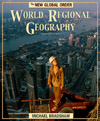 |  World Regional Geography: The New Global Order Update, 2/e Michael Bradshaw,
College of St. Mark and John
Latin America
Chapter ObjectivesAfter reading and studying this chapter you should be able to:
| 1. Understand that Latin America contains a mixture of peripheral and
semi-peripheral countries. |
 |  |  | | 2. Outline the numerous contrasts within this region. |
 |  |  | | 3. Explain how potential cooperation on trade is hampered by boundary
disputes. |
 |  |  | | 4. Know the three principal native civilizations that developed in favored
environments before European settlement began. |
 |  |  | | 5. Explain the impacts of Spanish and Portuguese colonization. |
 |  |  | | 6. List the various primary products that Latin America has exported from
colonial times to the 1990s. |
 |  |  | | 7. Trace postcolonial changes, modernization, and continued
dependency in Latin America. |
 |  |  | | 8. Describe the wide range of climates and landforms. |
 |  |  | | 9. Outline the natural resources that this region has in abundance. |
 |  |  | | 10. Examine the character and status of the Amazon rain forest. |
 |  |  | | 11. Describe the different regions of Mexico. |
 |  |  | | 12. Define the maquiladora program. |
 |  |  | | 13. Differentiate the seven countries of Central America from Mexico. |
 |  |  | | 14. Discuss the role of the United States in the politics and economics of
the West Indies. |
 |  |  | | 15. Compare and contrast the characteristics of Cuba and Puerto Rico. |
 |  |  | | 16. Analyze the impacts of cocaine production and drug trade in the
Northern Andes countries. |
 |  |  | | 17. Identify the changes that occurred in Bolivia after the revolution of
1951. |
 |  |  | | 18. Outline Brazil's many advantages and problems. |
 |  |  | | 19. Compare and contrast the characteristics of Argentina and Chile. |
 |  |  | | 20. Understand that Latin America has considerable future potential if
several concerns like large debts and disparity between rich and poor
can be overcome. |
 |  |  | | 21. Document the consequences for urban areas of massive rural to urban
migration. |
|



 2002 McGraw-Hill Higher Education
2002 McGraw-Hill Higher Education